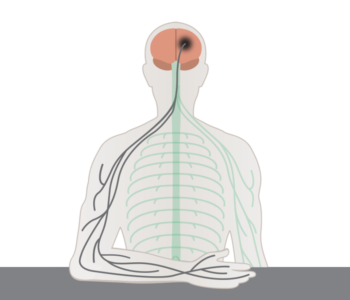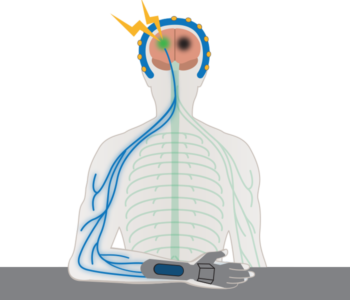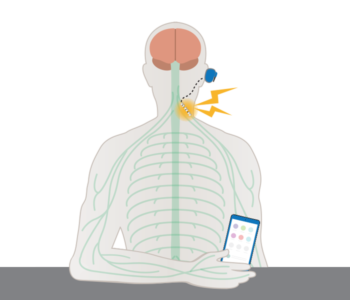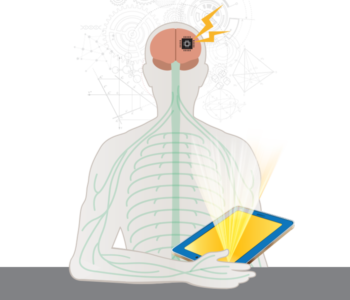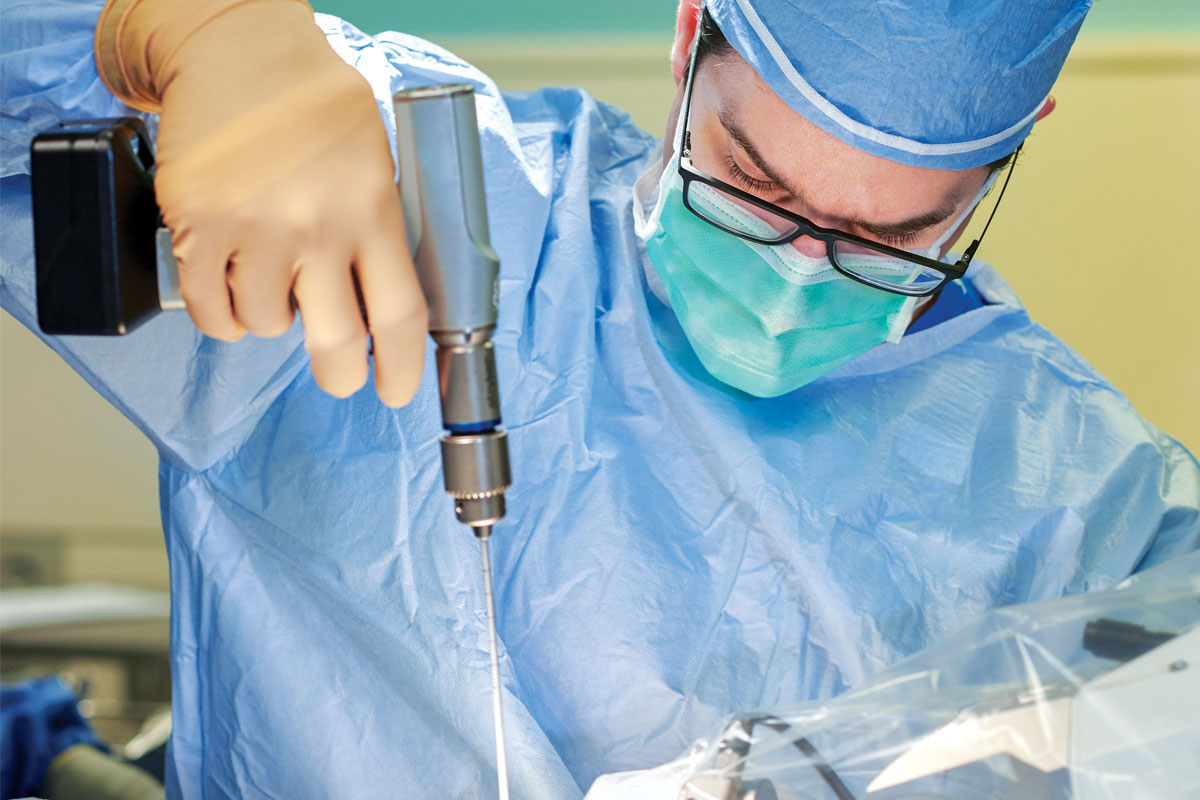
Shortly before 2 p.m. on a Monday, a group of writers, doctors and marketing gurus has convened in a North Building conference room to discuss putting on a play.
One of the production’s star performers arrives. Eric C. Leuthardt, MD, sits down and guides the group through details about the play, a four-part theatrical production debuting this summer that will take audiences to the frontiers of neuroscience.
While he speaks with the fluidity of a theater veteran, Leuthardt is still wearing scrubs. Performing plays is one of the many hats that the Washington University neurosurgeon wears as he educates society about the transformative potential of the brain. By tapping into his creative side, he hopes he can prime the public for what he foresees are upcoming breakthroughs in how we view the mind.
Through his groundbreaking research in the brain’s capacity to rewire itself, called neuroplasticity, it is his work in connecting brains to computers that guides his most ambitious goal: the one day widespread use of neural interfaces for anything from rehabilitating stroke patients to enhancing our own intelligence and memory.
With ample resources, he said he could make an implant as safe as LASIK eye surgery in as little as five years.
The bigger question is whether the world would be ready for surgeons to tinker with what Leuthardt calls “our most precious asset.” As technology marches forward, the brain — and its abstract counterpart, the mind — continues to be a sacred black box housing the essence of who we are.
“There’s a very dual reaction that we have where on one hand we’re fascinated as we learn about how the parts and gears of our mind work,” said Leuthardt, a professor of neurological surgery and of biomedical engineering. “At the same time, there’s another part of us that’s reticent to give up that mystery, that majesty.”
Leuthardt believes that one day we will warm to the idea of such implantable devices, called neuroprosthetics, just as the world has embraced smartphones tracking our movements and interactions.
For the last 20 years, Leuthardt has helped lead the biggest advances in how we view the relationship between technology and the brain. His research has ranged from non-invasive computer-based therapies for rehabilitating stroke patients to mapping a brain in as little as 15 minutes to laser-based minimally invasive techniques for killing types of brain tumors. Thanks to his efforts, a first-of-its-kind laser ablation surgical suite is looking to go live at Barnes-Jewish Hospital sometime within the next two years.

As director of Washington University’s Center for Innovation in Neuroscience and Technology, Leuthardt gathers neurosurgeons, engineers, mathematicians, physicists and computer scientists to collaborate and develop new technologies to improve neurosurgery.
“Even when he (Leuthardt) was a resident at Washington University, it was clear that he was a visionary and an excellent surgeon,” said Ralph Dacey Jr. MD, head of the Department of Neurosurgery. “He’s just surpassed all of our expectations in terms of his creativity, his inventions and the way he’s changed the care of our patients.”
Leuthardt couples his medical expertise with creative output to help the world see what can be achieved from the forefront of neuroscience. His work includes two science-fiction novels, a podcast entering its third year of production and an award-winning play. His next play provides a foundational understanding of the human brain — showing how adaptable it can be — and informs the public about treatment options today.
Leuthardt’s work probes the boundary where synapses end and the soul begins, sometimes posing uncomfortable questions about the role of the brain. Since his early days as a research intern, he continues to ponder its philosophical implications.
Biology with perspective
Leuthardt’s belief in the power of the neuroplastic brain began in fifth grade, when he was told he wasn’t very smart. Perhaps brain surgery wasn’t for him.
In high school, he interned with Keith Crutcher’s lab at the University of Cincinnati. Crutcher tasked Leuthardt with removing sympathetic ganglia from chicken embryos. Seeing he had a knack for it, a chief resident invited Leuthardt to shadow in the operating room.
Working there offered a lens through which to examine bigger questions posed by neuroscience. Leuthardt remembers passing time in Crutcher’s office, connecting their work to philosophy and the meaning of life.
Inspired by the scope of these conversations, Leuthardt decided to study both biology and theology at Saint Louis University.
“Theology was a deep dive into understanding the meaning of things, whether it’s with a religious bent, a philosophical bent or a psychological bent,” he said. “I almost think, in some sense, that the theology training I got was the more important degree to train me to be a physician and scientist.”
After starting his neurosurgery residency at Washington University in 1999, Leuthardt reached out to Dan Moran, PhD, a brain-computer interface researcher conducting his own experiments, and picked up a new set of skills outside of his medical training: engineering.
Leuthardt helped measure cerebral signals in epilepsy patients using implanted electrodes. After careful analysis, his group saw a pattern. Immediately before patients moved muscles, there was a burst of activity on the same side of the brain as the muscles being moved.
This defied the accepted notion of contralateral motor control — that neural signals cross the brain to control muscle movement on the opposite side of the body. Moving your left hand, it was thought, was done by the right side of the brain. The new findings, however, suggested the initial signal of intention to move occurred ipsilaterally, on the same side.
What was more, many signals for pre-motor planning could be detected by electroencephalography (EEG). This meant researchers could watch patients imagine moving their muscles with a non-invasive EEG machine resting on the scalp.
The group then studied stroke patients, whose brain damage left irreversible motor impairment. Even though the patients could not move their hands, EEG data showed they still could imagine moving them. Within a year, the researchers were able to use signals for imagined movement to move cursors on computers in the lab.
“Those endless hours to create one of the early prototype platforms for brain-computer interfaces was one of the most joyous years of my life,” Leuthardt said.
As his residency was ending, Leuthardt thought about how he could continue this work.
“I wanted to make brain-computer interfaces a clinical reality,” Leuthardt said. “So I looked at that and worked my way backward, asking myself, ‘What things do I need to do to change the world as it relates to brain-computer interfaces?’”
He developed a three-pronged strategy. First, he had to prove such technology would be helpful for patients. Next, he would demonstrate it could fund its own development beyond research grants. Finally, he needed to change public perceptions about neuroprosthetics.
Technologically, Leuthardt faced an issue of resolution. Despite the powerful potential implications the EEG techniques offered patients, EEG machines could only detect low-frequency activity through the scalp, a fraction of the data for such intricate processes.
“You can almost think of it like sound in a room,” Leuthardt explained. “As we’re talking, the high-frequency stuff doesn’t make it through the walls. The low-frequency stuff — the bass — makes it through the walls.”
Placing implants directly in the nervous system, then, could provide that higher resolution.
But putting invasive experimental computer chips in people’s brains is harder to sell.
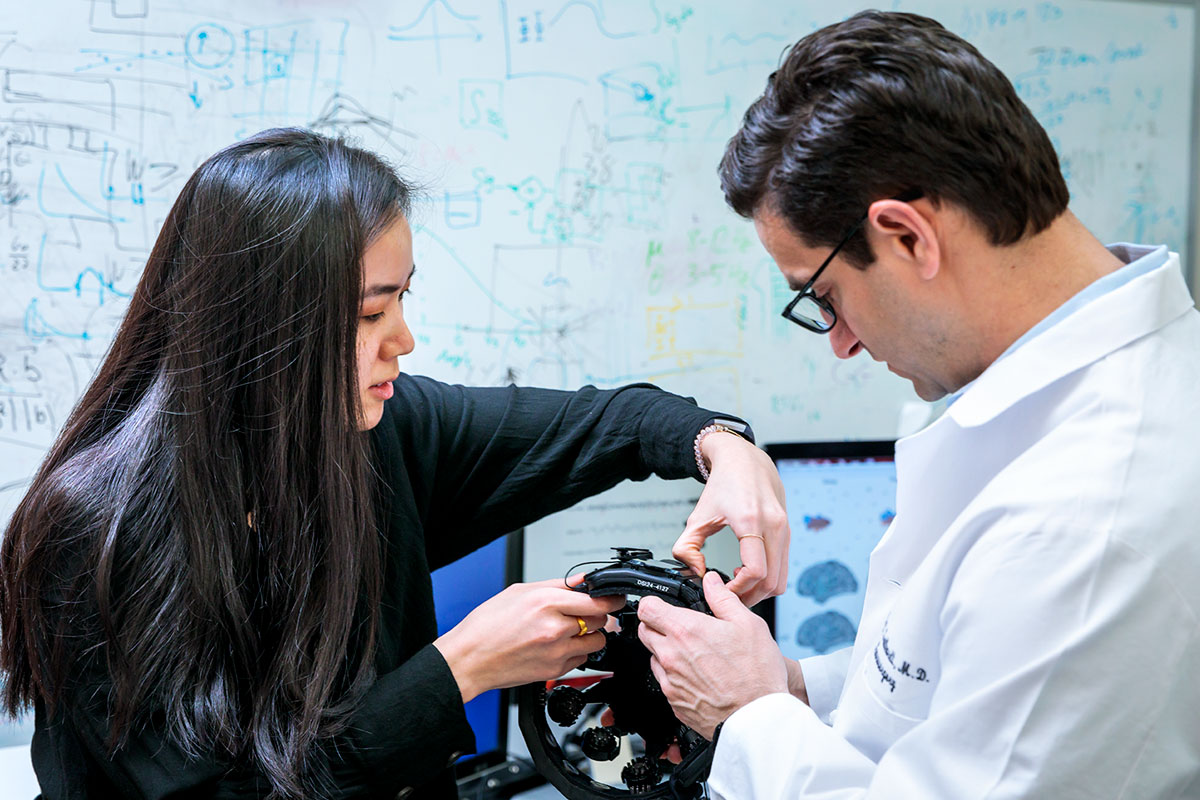
“Too science fiction”
Leuthardt’s first attempt at selling a neural implant proved instructive for how the social and market forces can affect medical innovation. From 2005 to 2007, he helped develop an implantable neuroprosthetic device that would help restore nerve function after spinal injuries.
The company failed to court enough investors to take off. In addition to the high cost to get it to market, Leuthardt said the concept was still considered “too science fiction.” The public did not seem ready to accept that a computer could assist in the analog act of moving muscles or that this would override the risk of potentially causing more damage in a procedure.
“Even though we were doing it and showing evidence for it, the world just couldn’t believe it at that time,” he added. “Nor was it ready to finance the risk of that. That crucible of forcing us to think in terms of market forces really reshaped our strategy and got us looking at doing brain-computer interfaces for stroke.”
Leuthardt returned to non-invasive therapies for stroke patients. This time, they went beyond moving cursors on a screen. Leuthardt’s team designed a robot worn on the patient’s hand that could translate his or her imagined movements into physical ones. This allowed patients to couple thoughts of movement with the sensation of the robots moving them.
These patients’ brains slowly rewired themselves to allow them to do tasks they hadn’t done in years, such as pick up a marble again.
By the end of their clinical trial in 2016, most of the patients saw meaningful improvements in as few as three months of sessions. The patients are working to return full use of their hands. However, the team was surprised to find that, after the initial rewiring, the patients continued to make improvements without the device.
The results provided a vivid view of what the neuroplastic brain was capable of.
“A powerful moment for me was a man not being able to put his pants on to being able to put his pants on,” Leuthardt said. “We had a woman who was deaf and couldn’t do sign language when she lost one of her hands, and now she can do sign language again.”
Rewiring the world
The non-invasive device, now called IpsiHand, is being developed by one of Leuthardt’s companies, Neurolutions.
Leuthardt heads several other companies, including eQuility, which promotes a less invasive vagus nerve stimulator for alleviating depression. Engaging the public is a key component that helps his technology gain wider acceptance and further drives his companies’ successes.

Leuthardt and Washington University neurosurgeon Albert H. Kim, MD, PhD, have launched the “Brain Coffee” podcast with Barnes-Jewish Hospital. In it, the longtime friends chat about the neuroscience topic du jour over coffee at Vincent Van Doughnut in The Grove neighborhood.
Leuthardt contributes to several blogs, including “Mind Blender” for Psychology Today, and has published two novels depicting the promise and perils of brain-computer interfaces. He uses them not only to drum up excitement for the neuroprosthetics but also to connect viscerally with readers and raise concerns about the potential dangers that come with neural augmentation. In his 2014 thriller, “RedDevil 4,” a neurosurgeon teams up with detectives to uncover how a brain-chip virus has turned ordinary citizens into murderers.
“These books aren’t Pollyanna,” he said. “In many ways, they’re cautionary tales. It gets people engaged and thinking about these things.”
Leuthardt views the steady fan mail from the novels as a bellwether indicating that implantable brain-computer interfaces are catching on.
At public talks, he polls audiences on whether they would consider getting a chip.
“Hardly anybody said they would when I started asking years ago,” he said. “Nowadays, most people raise their hand.”
Leuthardt now is focused on producing the follow-up to his successful 2016 play, “Brainworks: Your Mind on Life,” with Kim. The first “Brainworks” nabbed top honors in the “Informational/Instructional/Program Special” category in that year’s Mid-America Emmy awards.
The “Brainworks” plays aim to bring neuroscience to life as the duo deliver a play-by-play narration of neurobiology with actors portraying scenes from everyday life: coffeehouse mating rituals, competing in races, drinking alcohol. The plays originated as an attempt to make their regular public talks on neuroscience more engaging.
“After one of our joint talks in the community, we had someone come up to us and say that we need to bring this to Broadway. He said it half-jokingly, but we were really intrigued by the idea,” Kim said. “That was the brainchild of ‘Brainworks.’”
Audiences flocked to it, thanks to the approachability Leuthardt and Kim brought to the topics.
“Initially for the play, someone asked if we should wear our white coats on stage and we said, ‘No way! Absolutely not!’” Leuthardt said. “What we found was that people like to be part of the conversation.”
In Leuthardt’s office, the Emmy hangs alongside other artifacts and medical arcanum from over the years: a surgically altered goat vertebra that led to the company OsteoVantage; a first-edition copy of Michael Crichton’s “The Terminal Man”; early prototypes for brain-controlled robots.
Leuthardt said his creative work, much like his discoveries in research, speaks to a central truth that our brains are not fully programmed when we are born. His work with IpsiHand and other brain-computer interfaces he sees in the future has shown him that, with the help of computers, we can push our abilities even farther.
“So often we talk about the brain as a physical and the mind as this ethereal, separate part. Because of that, we always think of our minds as something that’s fixed. But that isn’t fair,” he said. “When you think about neuroplasticity and cognitive capacity, most people have the potential to be more than they ever thought they could be.”
Published in the Spring 2019 issue



